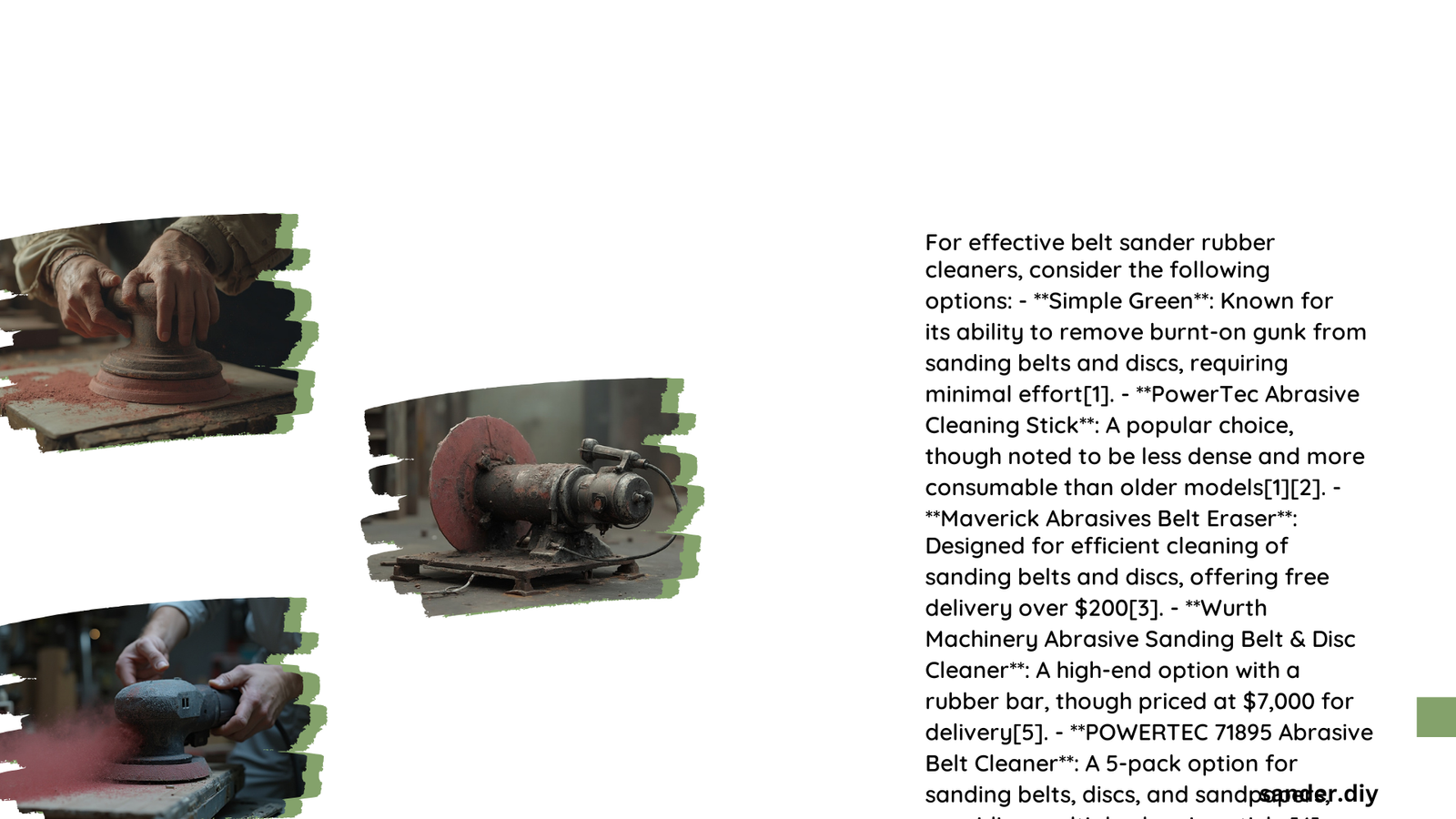Belt sander rubber cleaners are specialized tools designed to remove debris, resin, and other particles from sanding belts, extending their lifespan and maintaining optimal performance. These cleaners, typically made from natural or synthetic rubber, work through mechanical action rather than chemical processes. By effectively cleaning sanding belts, these tools help maintain the efficiency of belt sanders, ensuring smooth and consistent sanding results across various woodworking and metalworking projects.
What Are the Most Effective Formulations for Belt Sander Rubber Cleaners?
Belt sander rubber cleaners are primarily composed of natural or synthetic rubber, formed into cleaning sticks or blocks. Unlike liquid solutions, these solid cleaners rely on mechanical action to remove debris. The key components include:
- Natural rubber
- Synthetic rubber
- Abrasive-resistant compounds
These materials are carefully formulated to effectively clean sanding belts without damaging the abrasive surface. The rubber composition allows the cleaner to grip and remove particles stuck in the belt’s grit, restoring its sanding capability.
How to Remove Rubber Residue from Belt Sanders?

Removing rubber residue from belt sanders is a straightforward process when using a rubber cleaner. Follow these step-by-step instructions:
- Ensure Safety:
- Wear safety glasses and a dust mask
-
Secure the sander firmly
-
Prepare the Sander:
- Turn on the belt sander
-
Allow it to reach full operating speed
-
Apply the Cleaner:
- Hold the rubber cleaning stick firmly
- Press it gently against the running sanding belt
-
Move the stick back and forth across the belt’s surface
-
Inspect the Results:
- Turn off the sander
- Check the belt for any remaining debris
- Repeat the process if necessary
Remember to clean your sanding belts regularly, ideally after each use, to maintain optimal performance and extend their lifespan.
Which Are the Top-Rated Belt Sander Rubber Cleaners?
Several high-quality belt sander rubber cleaners are available in the market. Here’s a comparison of some top-rated options:
| Cleaner Name | Key Features | User Ratings |
|---|---|---|
| Powertec Sanding Belt Cleaner | – Professional-grade natural rubber – Removes various debris types – Available in 5-pack |
4.7/5 |
| Grizzly Industrial Belt Cleaner Stick | – Durable and efficient – Suitable for multiple abrasive tools – Professional and DIY use |
4.6/5 |
| Norton Abrasives Sanding Belt Cleaning Stick | – Excellent cleaning performance – Extends belt lifespan – Durable for frequent use |
4.5/5 |
These cleaners have received positive feedback from users for their effectiveness in maintaining sanding belts and improving overall sanding performance.
What Are the Best Practices for Using Belt Sander Rubber Cleaners?
To get the most out of your belt sander rubber cleaner and maintain your sanding belts effectively, consider the following best practices:
- Regular Cleaning:
- Clean belts after each use
-
For heavy use, clean multiple times during a session
-
Proper Technique:
- Apply consistent, moderate pressure
-
Move the cleaner across the entire belt surface
-
Environmental Considerations:
- Work in a well-ventilated area
-
Avoid extremely humid or dusty environments
-
Storage:
- Keep rubber cleaners in a cool, dry place
-
Avoid exposure to direct sunlight or extreme temperatures
-
Inspection:
- Regularly check belts for wear and tear
- Replace belts when cleaning no longer improves performance
By following these practices, you can maximize the effectiveness of your belt sander rubber cleaner and extend the life of your sanding belts.
How to Address Common Challenges with Belt Sander Rubber Cleaners?
While belt sander rubber cleaners are generally effective, users may encounter some challenges. Here’s how to address common issues:
- Glazed Belts:
- Problem: Soft woods can cause belts to ‘glaze’ over
-
Solution: Clean more frequently when working with soft woods
-
Stubborn Residue:
- Problem: Heavy resin or sticky substances resist cleaning
-
Solution: Use a more robust cleaning stick or combine with gentle scraping
-
Cleaner Wear:
- Problem: Rubber cleaner wears down quickly
-
Solution: Rotate the cleaner regularly for even wear
-
Belt Damage:
- Problem: Aggressive cleaning can damage belts
- Solution: Use gentle, consistent pressure and avoid overuse
By being aware of these challenges and their solutions, you can ensure optimal performance of both your belt sander rubber cleaner and your sanding belts.
What Are the Benefits of Regular Belt Sander Maintenance?
Regular maintenance of your belt sander, including the use of rubber cleaners, offers numerous benefits:
- Extended Belt Life: Regular cleaning can increase belt lifespan by 2-4 times.
- Consistent Performance: Clean belts provide more uniform sanding results.
- Cost Savings: Longer-lasting belts mean fewer replacements and lower costs.
- Improved Safety: Well-maintained equipment reduces the risk of accidents.
- Better Finish Quality: Clean belts produce smoother, more professional finishes.
Incorporating a belt sander rubber cleaner into your maintenance routine is a small investment that pays off in improved performance and longevity of your sanding equipment.
By following this comprehensive guide, you can make the most of your belt sander rubber cleaner, ensuring optimal performance and longevity of your sanding belts. Regular cleaning and proper maintenance will not only improve your sanding results but also contribute to a more efficient and cost-effective woodworking or metalworking process.
References:
1. https://www.gramconveyor.com/rubber-belt-cleaner/
2. https://www.combatabrasives.com/products/belt-cleaner
3. https://www.maverickabrasives.com/products/belt-cleaner
